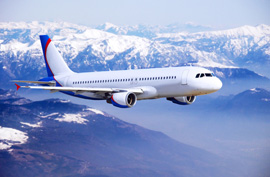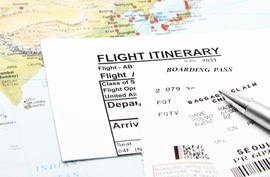
Discount Airfare Deals

Tips for Finding Cheap Airfare

Get Our Best Travel Deals and Tips

When is a round trip not a round trip? When it's a circle or open-jaw itinerary.
Thanks to the airlines' complicated and arcane fare structures, roundtrip flights almost always cost less than the sum cost of two one-way trips on the same route. (Discount airlines are a notable exception to this rule.) And most round trips go from Point A to Point B and back again.
But what if you need to do some traveling at your destination, and it's more convenient to fly home from a different airport? Or if you need to hit two or more cities in a short span of time, and want to do it in a single trip? If either situation applies to you, you may want to consider an open-jaw or circle ticket. Read on to learn how these special fares could save you money on your next multi-city itinerary.
The Open Jaw
An open-jaw flight is one that, in the simplest terms, flies from Point A to Point B, then from Point C back to Point A. Points B and C are often neighboring airports, or at least in the same general area. A sample open-jaw itinerary might be a flight from Atlanta to Seattle on the way out and from Portland, OR to Atlanta on the way back.
Another open-jaw scenario is to fly into and out of the same destination city, but your starting and finishing points are different, thus: Fly Point A to Point B; then fly Point B to Point C.
An open jaw is ideal for travelers who are planning to cover a lot of ground during their trip and who don't want to waste time returning to their original airport. Perhaps you fly into San Francisco and then drive down the coast of California to Los Angeles; an open-jaw fare would allow you to fly home out of LAX instead of making your way back up to San Francisco. Open jaws are also useful for cruise passengers whose sailings embark and disembark in different ports.
Despite the fact that an open-jaw itinerary isn't quite a classic round trip, most airlines treat it as such and charge you half the roundtrip fare of what each leg of the trip would cost you. So if the Atlanta - Seattle round trip would cost $400 and the Portland - Atlanta round trip would cost $500, you end up paying $200 for the first leg and $250 for the second leg, for a total of $450 roundtrip. The resulting total fare will typically offer considerable savings over the cost of two separate one-way flights.
There is such a thing as a double open jaw -- Point A to Point B on the way out, and then Point C to Point D on the return. While this is usually more expensive than a traditional open jaw, it may still save you money over two separate one-way flights.
The Circle

A circle itinerary typically begins and ends in the same city, but includes at least three separate flights that take you to two or more different cities without the overland portions of the open jaw.
Example: Fly from New York to Detroit, then Detroit to Houston, then Houston to New York. (Feel free to add Points D, E, F and beyond, but make sure you start and end at your original city -- New York in this example.)
Circle itineraries usually permit a maximum of two stopovers and are priced as a series of one-way flights. (Circle fares may not save you as much as an open jaw.) Still, circle fares qualify you for discounted fares, and you may even find that the fares on the separate legs of your flight add up to less than a pure roundtrip fare. This is especially true on popular long-haul routes.
Exceptions and Rules
Open Jaw
The most common restriction on an open-jaw itinerary is that the segment of your trip that you don't fly (the Seattle-Portland leg in our example) must be shorter than the shortest leg of the trip that you do fly.
So, for example, if you flew from Atlanta to Seattle, then drove cross-country to New York, then flew back to Atlanta, you couldn't qualify for the open-jaw discount, as the distance from Seattle to New York is much greater than the distance from New York to Atlanta.
Circle Fares
Restrictions and rules on circle itineraries vary by airline, but usually take one of the two following forms, both a variation on the old "Saturday night stay" rules:
1. You may not begin travel from the farthest geographical point of your trip until the first Sunday of your trip. Note that it is the farthest geographical point, not the place you stay the longest or schedule in the middle of your trip.
2. You may not begin the last leg of your trip until the first Sunday after the beginning of your trip.
The difference between the two is critical: in the first instance, the order in which you visit the cities is extremely important. In the latter instance, it is much less so.
If your airline has different rules for different segments of your trip, the whole trip will generally be subject to the most restrictive ones. So, for example, if one fare requires a 14-day advance purchase and the other a 21-day advance purchase, you'll need to book 21 days ahead in order to get the discounted circle fare.

How to Find Open Jaw and Circle Fares
Luckily, open-jaw and circle fares are not too difficult to find. Most online booking engines and airline Web sites can recognize a circle or open-jaw itinerary, and price them accordingly; just look for the multi-city search option. It might still be worth checking with your travel agent just to be sure. If prices seem high, call and ask if minor adjustments of your flight dates might help you qualify for either an open-jaw or circle itinerary.
Keep in mind, however, that these fares may not necessarily be your cheapest bet. If a discount airline serves all or part of your itinerary, check that carrier's one-way fares to see if they can beat what the big airlines are offering. For help finding low-cost carriers around the world, check out our guides:
Domestic Discount Airlines (U.S.)
International Discount Airlines
 Discount Airfare Deals
Discount Airfare Deals Tips for Finding Cheap Airfare
Tips for Finding Cheap Airfare Get Our Best Travel Deals and Tips
Get Our Best Travel Deals and Tips When is a round trip not a round trip? When it's a circle or open-jaw itinerary.
When is a round trip not a round trip? When it's a circle or open-jaw itinerary. A circle itinerary typically begins and ends in the same city, but includes at least three separate flights that take you to two or more different cities without the overland portions of the open jaw.
A circle itinerary typically begins and ends in the same city, but includes at least three separate flights that take you to two or more different cities without the overland portions of the open jaw. How to Find Open Jaw and Circle Fares
How to Find Open Jaw and Circle Fares